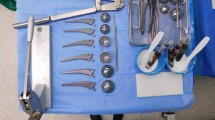Abstract
Objective
Two-stage exchange with implantation of a temporary spacer is considered gold standard treatment for chronic periprosthetic joint infection of the knee. This article describes a simple and safe technique for handmade articulating spacers at the knee.
Indication
Chronic or relapsing periprosthetic joint infection of the knee.
Relative contraindications
Known allergy against components of polymethylmethacrylate (PMMA) bone cements or admixed antibiotics. Inadequate compliance for two-stage exchange. Patient not able to undergo two-stage exchange. Bony defect situation at the tibia or femur leading to collateral ligament insufficiency. Soft tissue damage with need for plastic temporary vacuum-assisted wound closure (VAC) therapy.
Surgical technique
Removal of the prosthesis, thorough debridement of necrotic and granulation tissue, tailoring bone cement with antibiotics. Preparation of a tibial and femoral stem. Customizing the tibial and femoral articulating spacer components to bony anatomy and soft tissue tension. Confirmation of correct position by intraoperative radiography.
Postoperative management
Protection of the spacer with an external brace. Restricted weight-bearing. Passive range of motion as possible. Intravenous—followed by oral antibiotics. Reimplantation after successful treatment of infection.
Zusammenfassung
Zielsetzung
Der zweizeitige Wechsel mit Implantation eines temporären Spacers gilt als Goldstandard in der Behandlung chronischer periprothetischer Gelenkinfektionen am Knie. Im Beitrag wird eine einfache und sichere Technik für manuell erstellte Gelenkspacer am Knie vorgestellt.
Indikation
Chronische oder rezidivierende periprothetische Infektion am Kniegelenk.
Relative Kontraindikationen
Bekannte Allergie gegen Bestandteile von PMMA(Polymethylmethacrylat)-Knochenzementen oder zugesetzte Antibiotika. Keine ausreichende Compliance für einen zweizeitigen Wechsel. Der Patient ist nicht in der Lage, einen zweizeitigen Austausch zu überstehen. Knöcherne Defektsituation an Tibia oder Femur, die zu einer Insuffizienz des Lig. collaterale führt. Weichteilschädigung, die einen zeitweiligen plastischen vakuumunterstützten Wundverschluss („vacuum-assisted wound closure“, VAC) erfordert.
Operationstechnik
Entfernung der Endoprothese, gründliches Débridement von nekrotischem und Granulationsgewebe, Einbringen von Knochenzement mit Antibiotika. Vorbereitung von Tibia- und Femurschaft. Anpassung der tibialen und femoralen Gelenkkomponenten des Spacers an die knöchernen Bedingungen und die Spannungsverhältnisse im Weichgewebe. Bestätigung der korrekten Platzierung durch intraoperative Röntgenaufnahmen.
Postoperative Behandlung
Schutz des Spacers durch eine externe Bandage. Teilbelastung. Schmerzadaptiert freie Beweglichkeit. Intravenöse, anschließend orale Antibiose. Reimplantation nach erfolgreicher Behandlung der Infektion.






Similar content being viewed by others
References
Parvizi J, Gehrke T (2018) Proceedings of the International Consensus on Periprosthetic Joint Infection 2018. Hip Knee. J Arthroplasty. 2019 Feb;34(2S):S325–S327. https://doi.org/10.1016/j.arth.2018.09.045. Epub 2018 Oct 22. PMID: 30343971
Zahar A, Hannah P (2016) Addition of antibiotics to bon cement for septic prosthesis exchange. Oper Orthop Traumatol 28:138–144
Pelt CE, Grijalva R, Anderson L, Anderson MB, Erickson J, Peters CL (2014) Two-stage revision TKA is associated with high complication and failure rates. Adv Orthop 2014:659047
Juul R, Fabrin J, Poulsen K, Schroder HM (2016) Use of a new knee prosthesis as an articulating spacer in two-stage revision of infected total knee arthroplasty. Knee Surg Relat Res 28(3):239–244
Drexler M, Dwyer T, Kuzyk PR et al (2016) The results of two-stage revision TKA using Ceftazidime-Vancomycin-impregnated cement articulating spacers in Tsukayama Type II periprosthetic joint infections. Knee Surg Sports Traumatol Arthrosc 24(10):3122–3130
Haddad FS, Masri BA, Campbell D et al (2000) The PROSTALAC functional spacer in two-stage revision for infected knee replacements. Prosthesis of antibiotic-loaded acrylic cement. J Bone Joint Surg Br 82(6):807–812
Ghanem M, Zajonz D, Bollmann J, Geissler V, Prietzel T, Moche M et al (2016) Outcome of total knee replacement following explantation and cemented spacer therapy. GMS Interdiscip Plast Reconstr Surg DGPW 5:Doc12
Barrack RL, Engh G, Rorabeck C, Sawhney J, Woolfrey M (2000) Patient satisfaction and outcome after septic versus aseptic revision total knee arthroplasty. J Arthroplasty 15(8):990–993
Lau AC, Howard JL, Macdonald SJ, Teeter MG, Lanting BA (2016) The effect of subluxation of articulating antibiotic spacers on Bone defects and degree of constraint in revision knee arthroplasty. J Arthroplasty 31(1):199–203
Kalore NV, Maheshwari A, Sharma A, Cheng E, Gioe TJ (2012) Is there a preferred articulating spacer technique for infected knee arthroplasty? A preliminary study. Clin Orthop Relat Res 470(1):228–235
Krenn V, Morawietz L, Kienapfel H et al (2013) Histopathological classification of diseases associated with joint endoprostheses. Z Rheumatol 72(4):383–392
Haddad FS, Masri BA, Campbell D, McGraw RW, Beauchamp CR, Duncan CR (2000) The PROSTALAC functional spacer in two-stage revision for infected knee replacements. prosthesis of antibiotic-loaded acrylic cement. J Bone Joint Surg Br 82:807–812
Author information
Authors and Affiliations
Corresponding author
Ethics declarations
Conflict of interest
M. Lüdemann, S. von Hertzberg-Bölch, A. Gurok, J. Oberfeld and M. Rudert declare that they have no competing interests.
For this article no studies with human participants or animals were performed by any of the authors. All studies mentioned were in accordance with the ethical standards indicated in each case.
Additional information
Editor
Maximilian Rudert, Würzburg
Zeichnungen
Harald Konopatzki, Heidelberg
M. Lüdemann and S. von Hertzberg-Bölch shared first authorship.

Scan QR code & read article online
Rights and permissions
About this article
Cite this article
Lüdemann, M., von Hertzberg-Bölch, S., Gurok, A. et al. Handmade articulating spacer for two-stage exchange at the knee. Oper Orthop Traumatol 35, 154–162 (2023). https://doi.org/10.1007/s00064-023-00810-0
Received:
Revised:
Accepted:
Published:
Issue Date:
DOI: https://doi.org/10.1007/s00064-023-00810-0
Keywords
- Periprosthetic joint infection of the knee
- Two-stage revision arthroplasty
- Reoperation
- Polymethylmethacrylate bone cements
- Admixed antibiotics




